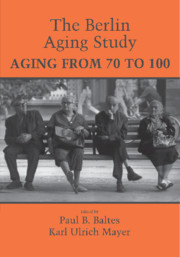Book contents
- Frontmatter
- Contents
- Acknowledgments
- Introduction
- Part A Theoretical Orientations and Methods
- Part B Major Results from the Four Research Units
- 5 Morbidity, Medication, and Functional Limitations in Very Old Age
- 6 Psychiatric Illnesses in Old Age
- 7 Trends and Profiles of Psychological Functioning in Very Old Age
- 8 Socioeconomic Conditions and Social Inequalities in Old Age
- Part C Interdisciplinary Findings
- Part D Overview and Outlook
- Notes on Contributors
- Abbreviations
- Author Index
- Subject Index
5 - Morbidity, Medication, and Functional Limitations in Very Old Age
Published online by Cambridge University Press: 06 December 2010
- Frontmatter
- Contents
- Acknowledgments
- Introduction
- Part A Theoretical Orientations and Methods
- Part B Major Results from the Four Research Units
- 5 Morbidity, Medication, and Functional Limitations in Very Old Age
- 6 Psychiatric Illnesses in Old Age
- 7 Trends and Profiles of Psychological Functioning in Very Old Age
- 8 Socioeconomic Conditions and Social Inequalities in Old Age
- Part C Interdisciplinary Findings
- Part D Overview and Outlook
- Notes on Contributors
- Abbreviations
- Author Index
- Subject Index
Summary
This chapter provides a brief overview of the main research topics, applied methods, and basic results of the Internal Medicine and Geriatrics Unit of the Berlin Aging Study (BASE). It focuses on (a) physical illnesses, (b) medication and related risks, and (c) functional incapabilites with regard to performanceoriented functional limitations and need for help with Activities of Daily Living (ADL). Profiles of functioning in each domain are presented from various perspectives. Particular emphasis lies on the recognition of potential determinants of morbidity in old age, exemplified by the atherosclerosis risk profile, and on the analysis of qualitative aspects of medication (over-, under-, and inappropriate medication). Finally, based on a recently proposed model of the disablement process in old age, these domains are considered from an integrated (systemic) perspective of health in old age with functional capacity at its center.
The results show a high degree of morbidity, but also indicate many modifiable risk factors for illness and disability, opening new vistas of prevention and therapy in old and very old age.
Introduction
Past decades of geriatric research have revealed much evidence indicating that morbidity is not only increased by age-related factors alone, but by modifiable organic risk factors such as fat metabolism disorders (Sorkin, Andres, Muller, Baldwin, & Fleg, 1992; Zimetbaum et al., 1992), functional risk factors such as falls (Tinetti, 1986), or iatrogenic risk factors such as inappropriate drug therapy (Beers et al., 1991; Williamson & Chopin, 1980).
- Type
- Chapter
- Information
- The Berlin Aging StudyAging from 70 to 100, pp. 131 - 166Publisher: Cambridge University PressPrint publication year: 1998
- 6
- Cited by

